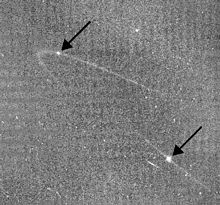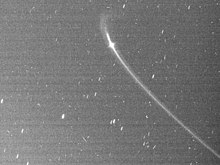Anthe (Mond)
| Anthe | |
|---|---|
| Bisher beste Aufnahme von Anthe am 30. Januar 2016 von Cassini aus einer Entfernung von 119.369 Kilometern | |
| Vorläufige oder systematische Bezeichnung | S/2007 S 4 |
| Zentralkörper | Saturn |
| Eigenschaften des Orbits | |
| Große Halbachse | 197.700 km |
| Periapsis | 197.500 km |
| Apoapsis | 197.900 km |
| Exzentrizität | 0,0011 |
| Bahnneigung | 0,100° |
| Umlaufzeit | 1,03650 d |
| Mittlere Orbitalgeschwindigkeit | 13,86 km/s |
| Physikalische Eigenschaften | |
| Albedo | ? |
| Scheinbare Helligkeit | 26,0 ? mag |
| Mittlerer Durchmesser | 1,8 km |
| Masse | 1,4987 · 1012 kg |
| Oberfläche | 10,l2 km2 |
| Mittlere Dichte | 0,5 g/cm3 |
| Fallbeschleunigung an der Oberfläche | 0,00012 m/s2 |
| Fluchtgeschwindigkeit | 0,55556 m/s |
| Entdeckung | |
| Entdecker | Cassini Imaging Science Team |
| Datum der Entdeckung | 30. Mai 2007 |
Anthe (auch Saturn XLIX) ist der zwölfte und einer der kleinsten der 82 bekannten Monde[1] des Planeten Saturn. Ihre Umlaufbahn liegt zwischen denen der großen Monde Mimas und Enceladus und die Monde dieses Abschnitts, zu dem auch Methone und Pallene gehören, werden die Alkyoniden-Gruppe genannt.
Entdeckung
Die Entdeckung von Anthe durch das Cassini Imaging Science Team auf Aufnahmen vom 30. Mai 2007 sowie früheren Aufnahmen, die bis Juni 2004 zurückreichen, wurde am 18. Juli 2007 bekannt gegeben. Anthe ist der 60. bestätigte Mond des Saturn-Systems.
Anthe erhielt zunächst die vorläufige Bezeichnung S/2007 S 4 und wurde von seinen Entdeckern inoffiziell Frank genannt. Im August 2007 wurde der Mond dann nach einer der sieben Töchter des Giganten Alkyoneus aus der griechischen Mythologie benannt (Alkyoniden). Alkyoneus war ein Sohn von Gaia und dem Blut von Uranos. Der Gigant kam im Gigantenkampf durch Herakles ums Leben. Anthe und ihre sechs Schwestern (darunter Methone und Pallene) waren über den Tod des Vaters so in Trauer, dass sie sich vom kanasträischen Vorgebirge ins Meer hinab stürzten. Aber aus Mitleid rettete ihnen die Okeanide (oder Nereide) Amphitrite das Leben und verwandelte sie in Eisvögel.
Bahneigenschaften
Umlaufbahn
Anthe umkreist Saturn auf einer prograden, fast perfekt kreisförmigen Umlaufbahn in einem mittleren Abstand von 197.700 km (ca. 3,280 Saturnradien) von dessen Zentrum, also etwa 137.430 km über dessen Wolkenobergrenze. Die Bahnexzentrizität beträgt 0,0011, die Bahn ist 0,1° gegenüber dem Äquator von Saturn geneigt, liegt also fast in der Äquatorebene des Planeten. Durch die niedrige Exzentrizität variiert die Bahn in der Entfernung zu Saturn um etwa 400 km.
Die Umlaufbahn des nächstinneren Mondes Methone ist im Mittel etwa 3.260 km vom Orbit von Anthe entfernt, die Entfernung der Bahn des nächstäußeren Mondes Pallene beträgt im Mittel etwa 14.600 km.
Anthe umläuft Saturn in 1 Tag, 0 Stunden, 52 Minuten und 33,6 Sekunden. Sie benötigt für einen Umlauf 38,8 Minuten länger als der innere Nachbar Methone. Sie legt in 24 Stunden eine Strecke von 347° zurück.
Anthe befindet sich in einer 10:11 Bahnresonanz mit dem innen laufenden Mond Mimas. Dadurch wird ihre Umlaufbahn von Mimas stark gestört. Der viel massigere Mimas verursacht durch seine Gravitation Abweichungen in der Methone-Bahn von etwa 200 km. Der Einfluss der Bahnresonanz führt auch dazu, dass sich Methone in 14° Länge auf ihrer Bahn vor und zurück bewegt.

Anthe-Ringbogen
Trotz der geringen Größe von Anthe wurde vor und hinter dieser im Juni 2007 ein Ringsystem entdeckt. Dieses bildet jedoch kein um den Saturn geschlossenes System, sondern es erstreckt sich nur einige tausend Kilometer vor und hinter Methone und wandert mit diesem mit.[2] Es wird angenommen, dass die Ringbögen von Anthe und auch Methone wahrscheinlich aus Material entstanden sind, das durch Mikrometeoriten aus diesen beiden Monden herausgeschlagen wurde. Durch die gravitative Resonanz mit Mimas werden sie von diesem in ihrer Form gehalten; Mimas verhindert also, dass sich das Ringmaterial wie bei den anderen Saturnringen auf der ganzen Bahn verteilt und einen gleichförmigen Ring formt.
Physikalische Eigenschaften

Anthe hat einen Durchmesser von etwa 1,8 km. Bei einer mittleren Dichte von 0,5 g/cm3 ergibt sich eine Masse von 1,4987 · 1012 kg. An ihrer Oberfläche beträgt die Schwerebeschleunigung 0,00012 m/s2, dies entspricht nur etwa 0,01 ‰ der irdischen.
Bislang gibt es zwei Theorien zur Entstehung der drei nahe beieinander liegenden Monde Methone, Anthe und Pallene: Erstens wurden sie von entweder Mimas oder Enceladus durch eine Kollision mit einem Kometen oder Asteroiden herausgebrochen, andererseits könnten alle diese fünf Monde sogar Rückstände eines größeren Schwarms sein, der in diese nahe Region von Saturn gewandert ist.[3]
Erforschung
Anthe weist eine scheinbare Helligkeit von 26,0m auf, die 1:13000000000 des Zentralplaneten beträgt. Methone wurde von bislang vier Raumsonden besucht, nämlich von den Vorbeiflugsonden Pioneer 11 am 1. September 1979, Voyager 1 am 12. November 1980 und Voyager 2 am 25. August 1981 (diese erfolgten ohne Sichtung des Mondes) und schließlich Cassini-Huygens.
Seit der Entdeckung 2007 konnten ihre Bahnparameter durch die Sonde Cassini, die seit dem 1. Juli 2004 den Saturn umkreist, präzisiert werden.
Medien
Weblinks
- IAUC 8857: S/2007 S 4 18. Juli 2007 (Entdeckung)
- IAUC 8873: Satellites of Saturn 20. September 2007 (Nummerierung und Benennung)
- Saturn turns 60 Presseerklärung des JPL (englisch)
Einzelnachweise
- ↑ Paul Rincon: Saturn overtakes Jupiter as planet with most moons. BBC, 7. Oktober 2019, abgerufen am 20. März 2020 (englisch).
- ↑ https://www.astronews.com/news/artikel/2009/06/0906-030.shtml
- ↑ Anthe: Overview (Memento vom 31. Mai 2015 im Internet Archive)
| weiter innen | Saturnmonde Große Halbachse | weiter außen |
| Methone | Anthe 197.700 km | Pallene |
Auf dieser Seite verwendete Medien
N00160284.jpg was taken on August 08, 2010 and received on Earth August 09, 2010. The camera was pointing toward ANTHE, and the image was taken using the CL1 and CL2 filters. This image has not been validated or calibrated. A validated/calibrated image will be archived with the NASA Planetary Data System in 2011.
Animated GIF of discovery images of Saturnian moon S/2007 S 4
Recent Cassini images show arcs of material co-orbiting with the Saturnian moons Anthe and Methone.
Arrows indicate the positions of Anthe, at top left, and Methone, at bottom right. Micrometeoroid impacts on the moons are the likely source of the arc material.
Cassini imaging scientists believe the process that maintains the Anthe and Methone arcs is similar to that which maintains the arc in the G ring (see Rounding the Corner). The general brightness of the image (along with the faint horizontal banding pattern) results from the long exposure time of 15 seconds required to capture the extremely faint ring arc and the processing needed to enhance its visibility (which also enhances the digital background noise in the image). The image was digitally processed to remove most of the background noise. This view looks toward the un-illuminated side of the rings from about 2 degrees above the ringplane.
The image was taken in visible light with the Cassini spacecraft narrow-angle camera on Oct. 29, 2007. The view was acquired at a distance of approximately 2.3 million kilometers (1.4 million miles) from Anthe and 2.2 million kilometers (1.4 million miles) from Methone. Image scale is 14 kilometers (9 miles) per pixel on Anthe and 13 kilometers (8 miles) on Methone.
The Cassini-Huygens mission is a cooperative project of NASA, the European Space Agency and the Italian Space Agency. The Jet Propulsion Laboratory, a division of the California Institute of Technology in Pasadena, manages the mission for NASA's Science Mission Directorate, Washington, D.C. The Cassini orbiter and its two onboard cameras were designed, developed and assembled at JPL. The imaging operations center is based at the Space Science Institute in Boulder, Colo.
For more information about the Cassini-Huygens mission visit http://saturn.jpl.nasa.gov . The Cassini imaging team homepage is at http://ciclops.org .Saturn's small moon, one of the Alcyonides, Anthe, is visible on one of the closest and best views ever taken. It was shot from a distance of 119369 kilometres on 30th January 2016.
Cassini images reveal the existence of a faint arc of material orbiting with Saturn's small moon Anthe.
The moon is moving downward and to the right in this perspective. In this image, most of the visible material in the arc lies ahead of Anthe (2 kilometers, or 1 mile across) in its orbit. However, over time the moon drifts slowly back and forth with respect to the arc. The arc extends over about 20 degrees in longitude (about 5.5 percent of Anthe's orbit) and appears to be associated with a gravitational resonance caused by the moon Mimas. Micrometeoroid impacts on Anthe are the likely source of the arc material. The orbit of Anthe lies between the larger moons Mimas and Enceladus. Anthe shares this region with two other small moons, Pallene (4 kilometers, or 3 miles across) and Methone (3 kilometers, or 2 miles across). Methone also possesses an arc (see PIA11102), while Pallene is known to orbit within a faint, complete ring of its own (see PIA08328).
Cassini imaging scientists believe the process that maintains the Anthe and Methone arcs is similar to that which maintains the arc in the G ring (see PIA08327). The general brightness of the image (along with the faint horizontal banding pattern) results from the long exposure time of 32 seconds required to capture the extremely faint ring arc and the processing needed to enhance its visibility (which also enhances the digital background noise in the image). The image was digitally processed to remove most of the background noise. The long exposure also produced star trails in the background. This view looks toward the un-illuminated side of the rings from about 3 degrees above the ringplane.
The image was taken in visible light with the Cassini spacecraft narrow-angle camera on July 3, 2008. The view was obtained at a distance of approximately 1.2 million kilometers (739,000 miles) from Anthe and at a sun-Anthe-spacecraft, or phase, angle of 12 degrees. Image scale is 7 kilometers (4 miles) per pixel.
The Cassini-Huygens mission is a cooperative project of NASA, the European Space Agency and the Italian Space Agency. The Jet Propulsion Laboratory, a division of the California Institute of Technology in Pasadena, manages the mission for NASA's Science Mission Directorate, Washington, D.C. The Cassini orbiter and its two onboard cameras were designed, developed and assembled at JPL. The imaging operations center is based at the Space Science Institute in Boulder, Colo.
The original NASA image has been resized and cropped.






